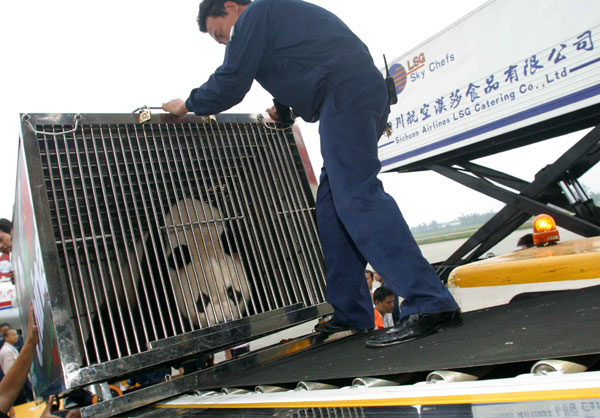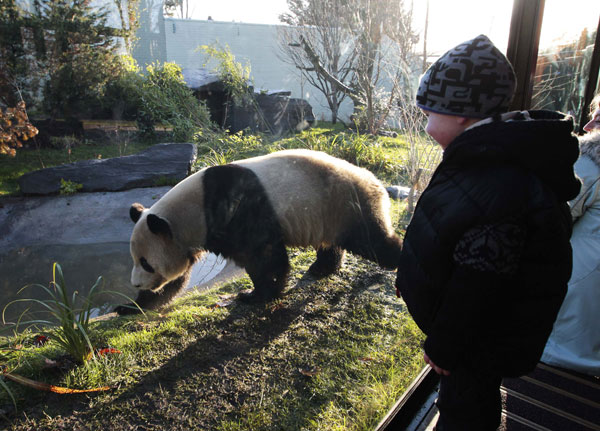Pandas may find traveling hard to bear
Updated: 2012-01-09 08:22
By Jiang Xueqing (China Daily)
|
||||||||
 |
|
Hua Zuiba begins a 30-hour journey to Spain in 2007. It took her several months to relax in her new home. [Xie Hui / for China Daily] |
Making the transition
To help the pandas adapt to their new environment more swiftly and smoothly, Chinese experts escort them to their new countries and teach local keepers and veterinarians how to raise captive pandas in a simulated wild environment.
It wasn't an easy transition for Wang Wang and Funi, who left Bifengxia for Adelaide Zoo in South Australia in November 1999. They had just developed extra fur for a Ya'an winter, when the average temperature is 5 degrees Celsius. In Adelaide, however, it was summer and 35 C on average. The pandas' thick coats prevented them from cooling easily.
During their first month, the pandas stayed all day inside, where the temperature was controlled at 18-20 C. The next month, keepers opened the enclosure door for a half-hour each day to encourage the pandas to go outside and get familiar with the new environment.
In a week, Wang Wang caught cold. He had a runny nose, lost his appetite and ran a fever as high as 38.9 C (normal is 37). Veterinarians diagnosed him with mild pneumonia and gave him medication. He recovered two days later.
Adelaide is Australia's driest state capital, with an annual average rainfall of just 549 mm, compared with more than 1,800 mm for Ya'an. It has only a couple of types of bamboo, which Wang Wang and Funi do not quite enjoy. To meet their dietary requirements, Adelaide Zoo began to fly in bamboo every week from Queensland in northeast Australia, according to Luo Bo, who took the pandas from Ya'an to Adelaide. The zoo also has a 14-hectare browse plantation at Bolivar, a northern suburb of Adelaide.
 |
|
Yang Guang draws attention as he explores his new enclosure at Edinburgh Zoo at a preview on Dec 12. The Scottish public got its first look four days later. [David Moir / Reuters] |
Homegrown supply
All of the zoos that receive pandas from China have found bamboo supplies in their own or nearby countries. At the US' National Zoo in Washington, each panda is fed about 23 kg of bamboo a day. Most of what they eat is grown on a farm in southern Maryland in the US.
"These countries do not import bamboo from China mainly because long-distance transportation expenses remain high," said Luo, who is deputy director of panda husbandry at China Conservation and Research.
"Besides, it is hard to preserve fresh bamboo during the trip. Not to mention that it usually takes one or two months for living plants like bamboo to go through the quarantine procedure before they are allowed for exportation."
The Edinburgh Zoo expects Tian Tian and Yang Guang to consume nearly 18,000 kg of bamboo every year, or about 20 three-meter stems each day.
Initially, German grower Reiner Winkendick is providing 85 percent of the animals' requirement with bamboo he produces at a nursery on the outskirts of Amsterdam. The rest is grown at special sites around the zoo. After three years, the zoo will increase its homegrown supply.

 Relief reaches isolated village
Relief reaches isolated village
 Rainfall poses new threats to quake-hit region
Rainfall poses new threats to quake-hit region
 Funerals begin for Boston bombing victims
Funerals begin for Boston bombing victims
 Quake takeaway from China's Air Force
Quake takeaway from China's Air Force
 Obama celebrates young inventors at science fair
Obama celebrates young inventors at science fair
 Earth Day marked around the world
Earth Day marked around the world
 Volunteer team helping students find sense of normalcy
Volunteer team helping students find sense of normalcy
 Ethnic groups quick to join rescue efforts
Ethnic groups quick to join rescue efforts
Most Viewed
Editor's Picks

|

|

|

|

|

|
Today's Top News
Health new priority for quake zone
Xi meets US top military officer
Japan's boats driven out of Diaoyu
China mulls online shopping legislation
Bird flu death toll rises to 22
Putin appoints new ambassador to China
Japanese ships blocked from Diaoyu Islands
Inspired by Guan, more Chinese pick up golf
US Weekly

|

|






